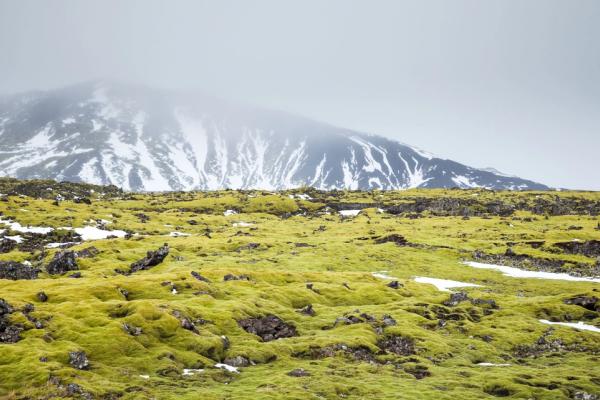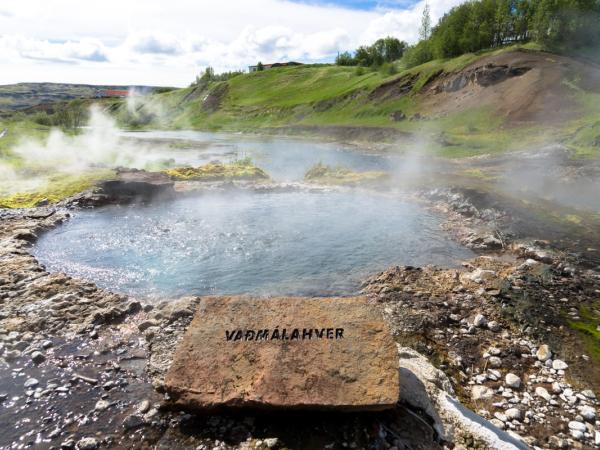
Iceland's Weather in April: The Dawn of Spring
April is a great time to visit Iceland. As spring arrives, the country starts to warm up from winter, bringing the first signs of summer. While temperatures begin to rise, the weather can still be pretty unpredictable, giving you a real taste of Iceland’s famous changing climate.
In this guide, we’ll walk you through what to expect weather-wise when visiting Iceland in April. We’ll also cover what to pack and highlight some great activities for this time of year.
Key Takeaways
- April in Iceland has a mix of leftover snow and early spring, with average temperatures in Reykjavik between 1°C and 6°C (33°F to 43°F).
- Pack warm layers and waterproof clothes, including thermal base layers, fleece tops, a waterproof jacket, sturdy pants, hiking boots, and a swimsuit for relaxing in geothermal pools.
- April is perfect for activities like whale watching, exploring Þingvellir National Park, and enjoying Golden Circle tours. Because road conditions can change, it’s smart to plan and book ahead.
- Knowing the rain levels and wind speed in April is important for a safe and fun trip, as Icelandic low-pressure systems can bring sudden weather changes.
Understanding Iceland’s Weather in April
April marks the start of spring in Iceland, a time when the country begins to thaw from winter. However, the weather can still be pretty unpredictable, with Icelandic low-pressure systems bringing a mix of rain, snow, and sunshine. One day might be mild and sunny, and the next could bring snow and icy conditions.
Despite the unpredictability, April is a wonderful time to visit. The days are getting longer, with up to 15 hours of daylight by the end of the month, giving you plenty of time to explore and enjoy outdoor activities. Plus, there’s still a chance to catch the Northern Lights in early April, adding a magical touch to your trip.

What is The Average Temperature in April in Iceland?
In April, average temperatures in Reykjavik usually range from highs around 6°C (42°F) to lows around 1°C (34°F). Northern areas like Akureyri can be a bit colder, with average lows dipping below freezing. While coastal regions enjoy milder temperatures, inland and higher-altitude areas might still see significant snow and colder conditions.
Keep in mind that road conditions can vary a lot across the country. Coastal weather tends to be more temperate, but the highlands might still be tricky to navigate due to lingering snow and ice.
How Much Does it Rain in April in Iceland?
Rain levels in April can vary, with Reykjavik getting about 60 mm (2.36 inches) of rain over roughly 8 rainy days. While April has less snow compared to the winter months, snow is still possible, especially in northern and highland areas. The mix of rain and snow adds to Iceland’s classic ever-changing weather.
Rain Patterns in April by Region
Rainfall across Iceland in April depends on where you are. The coastal weather brings more rain to the west and south coasts, while the north stays relatively drier but colder. The Snaefellsnes Peninsula, known for its stunning landscapes, also sees varied rain levels thanks to its exposure to Icelandic low-pressure systems.
| Days | Place | Inches | Milimeters |
| 8 | Akureyri | 1.6 | 41 |
| 10 | Dalatangi | 2.0 | 51 |
| 6 | Keflavik | 1.5 | 38 |
| 7 | Reykjavik | 2.4 | 61 |
| 9 | Reynisfjara Beach | 2.2 | 56 |
| 8 | Stykkisholmur | 1.8 | 46 |
The Weather in Different Regions of Iceland in April
Just like in August, the weather in April can vary a lot depending on where you are in Iceland. Knowing these regional differences is key for planning your activities and ensuring a smooth trip.
Reykjavik Weather
Reykjavik, Iceland’s capital, enjoys mild temperatures in April, typically ranging from 1°C to 6°C (34°F to 43°F). The city benefits from longer daylight hours but can still be windy and rainy. Despite the chill, Reykjavik is lively, with cultural events and plenty of outdoor activities to keep you entertained.
South Iceland Weather in April
Head south from Reykjavik, and you’ll find the temperature gets a bit warmer as spring starts to take hold. Rain levels stay moderate, and rainy days become more common as the month goes on. This area is perfect for exploring waterfalls like Seljalandsfoss and Skógafoss, and enjoying Golden Circle tours.
North Iceland Weather in April
The north remains one of the colder areas in April, with average temperatures dipping lower than in the south. However, it also sees fewer rainy days and more snow in higher areas. Akureyri, the main city in the north, is a great base for whale watching and exploring nearby natural spots.
The Central Highlands in April
The Central Highlands are mostly off-limits in April due to persistent snow and icy road conditions. However, some lower-altitude spots might start to thaw, offering early views of the region’s stunning landscapes. If you plan to explore this area, make sure to stay updated on road conditions and take the necessary precautions.
April 2024 Weather Recap
Take a look at how the weather was in April 2024 to get a better understanding of what you can expect from your trip in 2025.
April’s weather was a bit all over the place in Iceland in 2024. Reykjavík saw an incredible amount of sunshine, making it one of the sunniest April on record, while the northeast had a much tougher time with heavy snow and blizzards causing travel headaches. Most of the country stayed unusually dry, except for that snowy northeast corner. Temperatures were on the chilly side everywhere, with some spots hitting record lows. Let’s dive into the details:
Temperatures
Despite the abundant sunshine, the temperatures were well below the average across the country.
- Reykjavík: The average temperature in Reykjavík was 3.1°C (37.58ºF), which is 0.5°C below the 1991–2020 average and 1.3°C below the past decade's average.
- Akureyri: The average temperature in Akureyri was 0.8°C (33.44ºF), 1.8°C below the 1991–2020 average, and 2.9°C below the past decade's average.
Highest & Lowest Averages Nationwide
Below is a quick look at average temperatures and deviations for different locations across Iceland:
- The warmest average temperature was 4.7°C (40.46ºF) in Surtsey.
- The lowest average temperature was -5.1°C (22.82ºF) at Gagnheiði.
- Among inhabited areas, Svartárkot was the coldest, with an average of -3.6°C (25.52ºF).
- The warmest day of the month reached 16.5°C (61.7ºF) in Krafla on the 23rd.
- The coldest day was -22.3°C (-8.14ºF) in Svartárkot on the 5th.
April 2024 Extremes
- In Reykjavík, the coldest temperature was -6ºC (21.2°F) on April 6th, while the warmest reached 12ºC (53.6°F) on April 25th.
- In Akureyri, the coldest temperature was -18ºC (-0.4°F) on April 3rd, and the warmest was 10ºC (50°F) on April 20th.
Precipitation
April was generally dry, except in the northeast:
- Reykjavík recorded 21.5 mm of precipitation, about 36% of the 1991–2020 average, making it the eighth-driest April on record since measurements began.
- Akureyri saw 46.1 mm, about 80% above the 1991–2020 average.
- Stykkishólmur had 30.9 mm, while Höfn in Hornafjörður received 35.8 mm.
Days with 1.0 mm or more of precipitation:
- Reykjavík: 5 days (6 fewer than average)
- Akureyri: 9 days (3 more than average)
Snow
Heavy snowfalls in the north and east caused blizzards and frequent travel disruptions:
- Reykjavík had limited snow, with only one day of partial snow cover and bare ground for the rest of the month.
- Akureyri had 17 snowy days, with snow covering the ground each morning. This was far more than the average of 5 snowy days in April.
Sunshine
April brought plenty of sunshine, especially in Reykjavík:
- Reykjavík recorded 226.1 hours of sunshine, 61 hours above the 1991–2020 average, making it the fourth sunniest April on record since 1911.
- Akureyri recorded 146.2 hours, 18.7 hours more than average.

What to Pack For The Weather in April
Packing smart is key to enjoying your trip to Iceland in April. The variable weather means you need a versatile wardrobe that can handle both cold and mild conditions.
- Warm layers: Think thermal base layers, fleece tops, and insulating jackets to keep you cozy.
- Waterproof clothes: A good waterproof jacket and pants will protect you from unexpected rainy days and windy weather.
- Sturdy shoes: Waterproof hiking boots are a must for exploring different terrains.
- Accessories: Don’t forget hats, gloves, and scarves for those chilly moments.
- Swimsuit: Bring your swimsuit for soaking in geothermal pools like the Blue Lagoon.
Things to Pack
- Thermal clothing (base layer)
- Fleece tops
- Waterproof jacket/pants
- Long pants
- Hiking or trail shoes
- Swimsuit
- Hat, gloves, and scarf
- Small backpack for daily outings
What to Do in Iceland in April
April is a great month for a variety of outdoor and cultural activities. The melting landscapes and longer daylight hours make it perfect for exploring and adventuring.
- Whale Watching: With migrating species arriving, April is a prime time for whale-watching tours from Akureyri and Reykjavik.
- Golden Circle Tours: Discover iconic sites like Þingvellir National Park, Geysir, and Gullfoss waterfall.
- Hiking: Take advantage of the melting snow and blooming flowers with early spring hikes in accessible areas.
- Geothermal Pools: Relax in the Blue Lagoon or Secret Lagoon, enjoying the warm waters against the cool spring air.
- Northern Lights: Early April still offers a chance to see the Northern Lights, especially in the first half of the month.
- Cultural Events: Celebrate Iceland’s "First Day of Summer" with local parades and festivals.
Nature in April
Iceland’s natural beauty really starts to shine in April. The change from winter to spring brings lush greenery to the lowlands and the first blooms of the year. Þingvellir National Park offers beautiful views with its rift valleys and historic sites, while the Snaefellsnes Peninsula showcases dramatic coastlines and volcanic formations.
The Blue Lagoon is perfect for a relaxing soak, with warm geothermal waters contrasting nicely with the crisp spring air. Plus, the thawing landscapes provide fantastic opportunities for photography and outdoor adventures.
Cultural Events and Festivals in April
April is buzzing with cultural events in Iceland. The highlight is the celebration of the "First Day of Summer," a major event marked by parades, local fairs, and various festivities across the country. These celebrations give you a wonderful chance to experience Icelandic traditions and community spirit up
Tips For Your Trip, With the Weather in Mind
Here are some handy tips to make sure your trip to Iceland in April goes smoothly:
- Pack lightly but wisely: Focus on versatile, layered clothes to adapt to changing conditions.
- Plan and book ahead: Secure your places to stay and activities, especially popular tours like Golden Circle Tours.
- Respect nature: Follow the rules to help keep Iceland’s environment clean and beautiful.
- Check the weather often: Stay updated on current conditions to change your plans if needed.
- Look at road conditions before you head out each day: Use websites like road.is to ensure safe travel.
- Choose guided tours: Especially for remote or highland areas, guided tours can make your trip safer and more enjoyable.
- Stay flexible: Be ready to change your plans based on the weather.
Take Advantage of April's Weather in Iceland
Visiting Iceland in April offers a unique mix of winter leftovers and the first signs of summer. The spring season provides a quieter, more peaceful experience with fewer tourists, allowing you to explore the country’s natural and cultural treasures more closely.
Whether you’re chasing the Northern Lights in the early part of the month or enjoying the blossoming landscapes later on, April is a memorable time to discover Iceland’s amazing beauty.






